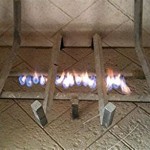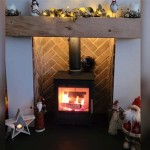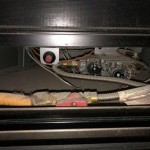Wood Zero Clearance Fireplace: A Comprehensive Guide
A wood zero clearance fireplace, also known as a ZC fireplace or factory-built fireplace, represents a prefabricated heating appliance designed for installation within a framed enclosure. Unlike traditional masonry fireplaces built on-site, these units are constructed in a factory to rigorous safety standards and offer significant advantages in terms of installation flexibility, efficiency, and cost-effectiveness.
The term "zero clearance" refers to the fireplace's ability to be installed directly against combustible materials, such as wood framing, without posing a fire hazard. This is achieved through a combination of insulation, air circulation, and a double or triple-walled construction that keeps external surfaces relatively cool. This feature drastically simplifies the installation process and reduces the need for extensive masonry work.
Wood zero clearance fireplaces are typically comprised of a firebox constructed from heavy-gauge steel or cast iron, surrounded by an insulated outer shell. A listed chimney system, specifically designed for use with the fireplace, vents the exhaust gases safely away from the living space. The appliance is typically enclosed by a decorative surround, often referred to as a mantel or facing, which can be customized to match the aesthetic of the room. These fireplaces provide a convenient and effective way to enjoy the ambiance and warmth of a wood-burning fire without the complexity and expense associated with traditional masonry fireplaces.
Understanding the Key Features and Benefits
Zero clearance fireplaces present a compelling alternative to traditional fireplaces, offering a range of features and benefits that make them a popular choice for homeowners. These advantages stem from their factory-built construction and careful design, resulting in enhanced safety, efficiency, and ease of installation.
One key advantage is the simplified installation process. Because they are pre-fabricated and designed for zero clearance to combustible materials, ZC fireplaces require less framing and foundation work compared to masonry fireplaces. This reduces labor costs and installation time considerably. The lightweight nature of the units also allows for installation on upper floors, where the structural support for a traditional fireplace might be insufficient.
Another important benefit is enhanced safety. ZC fireplaces are subjected to thorough testing and certification by independent agencies such as UL (Underwriters Laboratories) or CSA (Canadian Standards Association). These certifications ensure that the fireplace meets stringent safety requirements for fire containment, emissions, and structural integrity. The insulated design also minimizes the risk of accidental burns from contact with the exterior surfaces of the fireplace.
Improved heating efficiency is yet another advantage. Modern ZC fireplaces often incorporate features such as airtight fireboxes, insulated firebricks, and air wash systems to maximize heat output and minimize heat loss. Some models also include optional blowers that circulate heated air into the room, further enhancing their heating capabilities. This increased efficiency translates to lower fuel consumption and reduced heating costs.
Finally, ZC fireplaces offer a wide range of design options to suit various aesthetic preferences. They are available in a variety of sizes, styles, and finishes, allowing homeowners to select a fireplace that complements their existing décor. Options include traditional designs with ornate mantels, contemporary designs with clean lines, and even corner models that maximize space utilization. The versatility in design makes ZC fireplaces a suitable choice for almost any home.
Installation Considerations and Best Practices
While zero clearance fireplaces offer simplified installation compared to masonry fireplaces, it is crucial to adhere to established installation guidelines and best practices to ensure safe and efficient operation. Proper installation not only prevents fire hazards but also maximizes the fireplace's heating performance and longevity.
Firstly, it is essential to consult the manufacturer's installation manual for specific instructions and requirements. The manual provides detailed diagrams and step-by-step guidance on framing, venting, and finishing the fireplace enclosure. Failure to follow these instructions can void the warranty and compromise the safety of the installation. The manual will also specify the required clearances to combustible materials, which must be carefully observed even though the unit is designed for zero clearance in many areas.
Secondly, proper venting is paramount. The chimney system must be compatible with the fireplace and installed according to the manufacturer's specifications. This includes ensuring the correct chimney height, diameter, and material. The chimney must also be properly insulated to prevent condensation and creosote buildup, which can pose a fire hazard. Regular chimney inspections and cleaning are essential to maintain safe and efficient venting. Obstructions such as bird nests or debris should be removed promptly.
Thirdly, proper framing and enclosure construction are critical. The fireplace enclosure must be built from fire-resistant materials and adequately insulated to prevent heat transfer to surrounding combustible materials. The framing should be sturdy enough to support the weight of the fireplace and any associated facing materials. The enclosure should also be designed to allow for proper air circulation around the fireplace, preventing overheating and maintaining optimal performance. The use of non-combustible materials for the facing and hearth is highly recommended.
Fourthly, consider professional installation. While some homeowners may be tempted to install a ZC fireplace themselves, it is generally advisable to hire a qualified and experienced installer. A professional installer will have the necessary knowledge, skills, and tools to ensure that the fireplace is installed correctly and safely. They can also advise on proper venting, framing, and finishing techniques. Moreover, professional installation may be required to maintain the manufacturer's warranty.
Finally, ensure compliance with local building codes and regulations. Before installing a ZC fireplace, it is important to check with the local building department to determine any applicable codes and permit requirements. Compliance with these regulations is essential for ensuring the safety and legality of the installation. The building inspector may need to inspect the installation after completion to verify compliance with code requirements.
Fuel Selection and Maintenance
The type of fuel used in a wood zero clearance fireplace significantly impacts its performance, emissions, and lifespan. Proper fuel selection and regular maintenance are essential for maximizing the fireplace's efficiency, minimizing pollution, and preventing safety hazards.
The primary fuel for wood ZC fireplaces is, of course, seasoned firewood. Seasoned wood has a moisture content of 20% or less, which allows it to burn more cleanly and efficiently. Burning wet or green wood produces excessive smoke, creosote, and pollution. Seasoning firewood typically involves splitting the wood and air-drying it for at least six months to a year. Hardwoods, such as oak, maple, and ash, generally provide more heat and burn longer than softwoods, such as pine and fir. However, softwoods can be used for kindling or to start the fire.
Avoid burning treated wood, painted wood, or construction debris in a ZC fireplace. These materials can release harmful chemicals into the air and damage the fireplace. Plastics, trash, and cardboard should also never be burned in a fireplace. The combustion of these materials can produce toxic fumes and contribute to air pollution.
Regular maintenance is crucial for ensuring the safe and efficient operation of a wood ZC fireplace. This includes regular chimney inspections and cleaning to remove creosote buildup. Creosote is a flammable substance that accumulates in the chimney as a byproduct of burning wood. If creosote buildup becomes excessive, it can ignite and cause a chimney fire. The chimney should be inspected at least once a year and cleaned as needed by a qualified chimney sweep.
The firebox should also be cleaned regularly to remove ash and debris. Excess ash buildup can reduce the efficiency of the fireplace and make it difficult to start a fire. The ash can be removed with a shovel and placed in a metal container with a tight-fitting lid. The container should be stored outdoors away from combustible materials. It's best to wait until the ashes are completely cold before removing them, typically several days after the last fire.
The fireplace door and glass should also be cleaned regularly to remove soot and grime. Special fireplace glass cleaners are available for this purpose. Abrasive cleaners should be avoided, as they can scratch the glass. The gaskets around the door and glass should also be inspected periodically and replaced if they are worn or damaged. Worn gaskets can allow air to leak into the firebox, reducing efficiency and increasing emissions.
Finally, inspect the fireplace and chimney for any signs of damage or deterioration. Cracks, rust, or loose bricks should be repaired promptly to prevent further damage and ensure the structural integrity of the fireplace. If any significant problems are detected, it is best to consult a qualified fireplace professional for assessment and repair advice.

Is A New Zero Clearance Fireplace Right For You Design Styles Sizes

Zero Clearance Wood Fireplace Ventis He350 Best Fireplaces Rockford Chimney

Fireplace Insert Vs Zero Clearance Maple Mtn

Hearthstone Wfp 75 Montgomery 8411 Zero Clearance Wood Burning Fireplace Mazzeo S Stoves Fireplaces

Wood Burning Fireplaces Fireplace Installations

Rsf Pearl Woodburning Zero Clearance Fireplace Fergus

Osburn Everest 2 Zero Clearance Wood Stove Fireplace Fireplaces By Cameron

Top 9 Benefits Of Installing A Zero Clearance Fireplace We Love Fire

Renaissance Rumford L50 Linear Woodburning Zero Clearance Fireplace Fergus

Osburn Everest Ii Wood Burning Zero Clearance Fireplace Rockford Chimney
Related Posts








